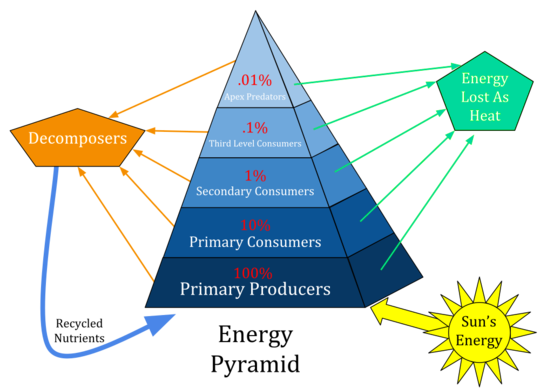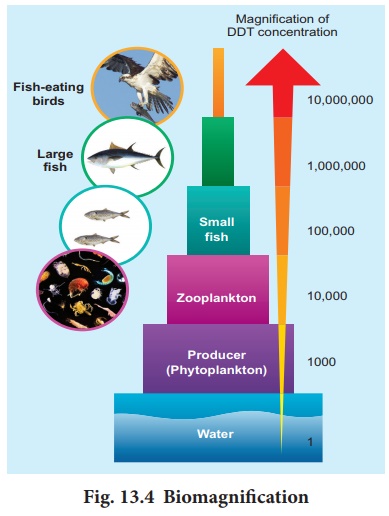Energy Flow Through Ecosystems Study Guide
Introduction:
Autotrophs (producers) generate their energy, resulting in organic molecules that heterotrophs use as fuel (consumers). So, let’s know more about the process of energy flow in this article.
Energy Flow:
Food’s chemical energy is the primary energy source for all living beings. This energy is sent down the food chain to various trophic levels. Two separate thermodynamic laws govern this energy flow:
- The first rule of thermodynamics holds that energy cannot be generated or destroyed; instead, it can only change forms.
- The second law of thermodynamics asserts that it is transferred more and more when energy is transmitted.
Organisms use energy to maintain organization, grow, and reproduce:
Organisms use different strategies to regulate body temperature and metabolism.
-
Endotherms use thermal energy generated by metabolism to maintain homeostatic body temperatures. Examples are polar bears, penguins and us humans too! This means that our internal body temperature does not depend on the temperature of the environment.
-
Ectotherms lack efficient internal mechanisms for maintaining body temperature. Animals such as snakes, fishes and most reptiles regulate their temperature behaviorally by moving into the sun or shade. This means that their internal body temperature depends on the temperature of the environment.
Different organisms use various reproductive strategies in response to energy availability.
There is a relationship between metabolic rate per unit body mass and the size of multicellular organisms—generally, the smaller the organism, the higher the metabolic rate.
- A net gain in energy results in the energy storage or the growth of an organism.
- A net loss of energy results in loss of mass and, ultimately, the death of an organism.
One of the primary variables that support the survival of such a large number of creatures is the energy flow in the ecosystem.
- Solar energy is the principal energy source for practically all species on the planet.
- The earth’s atmosphere normally reflects most of the sun’s energy that falls on it back into space. The Photosynthetically Active Radiation is the name of this effective radiation (PAR).
- Overall, we obtain roughly 40 to 50 percent of our energy from Photosynthetically Active Radiation, with plants using just 2-10 percent of it for photosynthesis. As a result, this percentage of PAR benefits the entire planet since plants are the ecosystem’s producers. All other creatures are either directly or indirectly reliant on them for existence.
- Ecosystem producers are known as autotrophs because they are able to make their own food in the form of carbohydrates from raw materials and energy. Autotrophs include plants, algae, and some types of bacteria (photosynthetic organisms).
- Chemosynthetic autotrophs make food using energy from chemical reactions instead of the sun. Bacteria found in deep ocean hydrothermal vents are examples of such organisms and can produce food in the absence of oxygen.
- Heterotrophs cannot produce their own food and are known as consumers. They consume producers (plants) or other consumers( animals) for their energy and nutrient requirements. Our dogs, cats, birds, fish, bacteria and us too are all examples of heterotrophs.
- The energy is transferred through the food chain and web. Plants, as producers, collect sunlight through their chloroplasts and convert a portion of it into chemical energy through photosynthesis.
- When herbivores eat (primary consumers) the plants as food, this energy is stored in various organic products and transferred to the primary consumers in the food chain. The chemical energy held in plant products is then converted into kinetic energy, and the energy is then degraded by being converted into heat.
- After that, there are secondary consumers. Further deterioration will occur when these herbivores are consumed by first-order predators (secondary consumers). Finally, energy will be depleted when tertiary consumers eat carnivores. As a result, the energy flow is unidirectional.
- Furthermore, the energy flow in a food chain follows the 10% law. Only 10% of energy is transported from one trophic level to the next. According to this equation, the remainder is lost to the atmosphere.
Productivity in trophic levels:
- The quantity of energy assimilated into biomass is characterized as productivity, assessed by gross and net primary productivity.
- The entire mass of living and previously-existing animals within a trophic level is called biomass; ecosystems contain different quantities of biomass at different trophic levels.
- Primary producer productivity (gross primary productivity) is critical to ecosystems since these creatures provide energy to other living things.
- At the next trophic level, net primary productivity (energy left in primary producers after accounting for respiration and heat dissipation) is accessible to primary consumers.
Food chain:
In the ecosystem, there are three main types of food chains, namely —
- Grazing food chain (GFC)– Plants are the producers in the grazing food chain (GFC), and energy passes from the producers to herbivores (primary consumers), then to carnivores (secondary consumers), and so on.
- Saprophytic or Detritus food chain (DFC) — In this food chain, dead organic matter is at the bottom of the food chain, followed by decomposers, etc.
- Parasitic food chain (PFC) — In this food chain form, huge creatures are exploited as producers or consumers, and food is passed down to smaller organisms.
We usually study food webs in nature since there are many omnivorous creatures. As a result, they inhabit a variety of trophic levels.
Ecological Pyramids:
- The biomass, energy, and quantity of creatures in each trophic level are represented by ecological pyramids, inverted or upright.
- Depending on the ecology, number pyramids can be upright or inverted.
- The quantity of energy turned into living tissue at various trophic levels is measured using biomass pyramids.
- Energy flow across the trophic levels may also be shown using pyramid ecosystem modeling; energy pyramids are always upright since energy declines with each trophic level.
Bio-magnification:
- When harmful compounds are released into the environment, the species at the top of the food chain are the ones who suffer the most.
- The concentration of hazardous chemicals in organisms at higher trophic levels rises due to biomagnification.
- DDT is an example of a biomagnifying drug; birds collect enough DDT by eating fish to impact bird populations negatively.
- Heavy metals in some forms of seafood, such as mercury and cadmium, can potentially bio-magnify.
Conclusion:
- Food’s chemical energy is the primary energy source for all living beings. This energy is sent down the food chain to various trophic levels.
- Solar energy is the principal energy source for practically all species on the planet.
- The quantity of energy assimilated into biomass is characterized as productivity, assessed by gross and net primary productivity.
FAQs:
1. What does the energy flow through an ecosystem depend on?
For species and the ecosystems in which they live, the Sun is the primary source of energy. Sunlight energy is used by producers such as plants, algae, and cyanobacteria to create organic matter.
2. Why is energy flow in an ecosystem not efficient?
The second law explains why no energy transmission can ever be 100% efficient. Because ecological efficiency is so poor, each trophic level may take energy from a smaller and less energy source. This is why trophic levels in food webs are limited to four to five.
3. Why is energy flow in the ecosystem important?
The ecosystem’s energy flow is critical for maintaining ecological equilibrium. Photosynthesis is used by the producers to create food. Plants store a portion of the energy they generate. The primary consumers(herbivores) use the leftover energy for their growth and development.
4. In what direction does energy flow in ecosystems?
An ecosystem’s energy flows in just one direction. Energy is transferred from one trophic level or energy level to the next trophic level or energy level. Biomagnification
We hope you enjoyed studying this lesson and learned something cool about Energy Flow Through Ecosystems! Join our Discord community to get any questions you may have answered and to engage with other students just like you! Don’t forget to download our App and check out our awesome VR room for this guide – we promise, it makes studying much more fun 😎
Sources:
- Energy flow in ecosystems https://apcentral.collegeboard.org/pdf/ap-biology-course-and-exam-description-0.pdf?course=ap-biology Accessed on 30 Dec, 2021
- Biomaginification https://www.brainkart.com/article/Biomagnification_38169/ Accessed on 30 Dec, 2021


